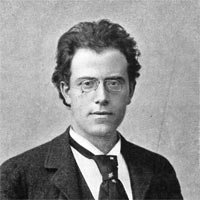Mahler's 8th Symphony - The Master's Monumental Epic
Mahler's Symphony no. 8, The "Symphony of a Thousand", is an overwhelmingly epic achievement. One of the biggest works ever created in classical music, the premiere did indeed feature over 1,000 musicians (an orchestra plus various choruses), with Mahler conducting.
But Mahler didn't actually like the name, and it's rare that the piece is performed with so many musicians nowadays.
The symphony is also interestingly constructed. Rather than the typical 4-movement symphonic layout, Mahler created a 2-part epic. The first section is a musical setting of a Latin hymn (Veni, Creator Spiritus), while the second, much longer section is a setting of the last part of Goethe's classic Faust.
Mahler had wanted for a long time to put the ending of Faust into music, but to do it in a better way than other composers had in the past.
So how did this monumental work come about?
History
"I saw the whole piece immediately before my eyes and only needed to write it down, as though it were being dictated to me." ~ Mahler
Mahler composed his 8th symphony in a short, manic burst in the summer of 1906.
The composer was on holiday in the south of Austria. He was suffering from a lack of inspiration, and was getting a bit down, until suddenly a divine flash ignited his mind with a new idea. He frantically poured his energy into writing down his newest symphony. He finished it in an amazingly short amount of time.

But despite the short time it took to compose, it took several years before the world finally heard it performed. Mahler contacted the concert promoter Emil Gutmann to schedule a premiere for 1910 in Munich.
Gutmann hired a massive hall, and coined the name "Symphony of a Thousand" to draw in the crowds and create a buzz about the new piece. But Mahler himself didn't like the title, and thought Gutmann was going to ruin his beloved symphony with gaudy promotion tactics.
But Mahler was nervous about the premiere for other reasons as well. The sheer number of performers was a big hindrance - perfect scores had to be copied out by hand in the hundreds, which was nigh on impossible.
Also, the various sections of the grand chorus would have to rehearse in different cities all over Germany. Mahler was also busy in New York and couldn't have complete run throughs with his choruses until close to the premiere.
Mahler's Symphony 8 was the composer's greatest composition yet - but because it was so grand there was a real threat that the premiere would catastrophically collapse before the world heard the piece properly! The poor composer felt that he was being strong-armed into going ahead with the premiere by the overzealous Gutmann.
The eventual performance was on 12 September 1910. The audience was studded with the cream of society: aristocrats, famous writers, musicians and composers.
Mahler strode to the conducting podium to face the 1,030 musicians he was about to lead, but the audience broke into a standing ovation before he could begin!
Audiences hadn't been that warm to previous Mahler symphony, but the 8th was different. The reception was unanimously positive - the grand symphony was a huge success! The 3,000+ members of the audience clapped and clapped.
Tragically, 8 months later Mahler died.
Music
The "Symphony of a Thousand" has other peculiarities apart from the ridiculously large ensemble it needs. It's only in two parts, with no break in the middle, and a typical performance lasts almost an hour and a half!
The poor performers need a lot of energy to get through it. This includes the organist, 3 sopranos, 2 altos, and a tenor, baritone and a bass singer. Don't forget the chorus of children.... and the 2 full-sized choirs!
The 2 parts of the symphony are unusually different. The first is a 9th century hymn in Latin Veni creator spiritus, and the second part is the finale of Goethe's Faust. 1000 years separates these 2 scripts, but Mahler sticks them together nonetheless!
Beethoven's famous 9th symphony is similarly epic and lavish...
Best Recordings
Conductor Robert Shaw's recording, with the Atlanta Symphony Orchestra, is popular - for a reason! Shaw manages to balance everything nearly perfectly, avoiding the common pitfalls other conductors trip up on.
Juggling the different energies and temperaments of each group of performers in this piece is very difficult, but Shaw manages to keep everything flowing while still keeping power in reserve for the finale. Recommended!
If you like my site, please click "Like"... thanks!


